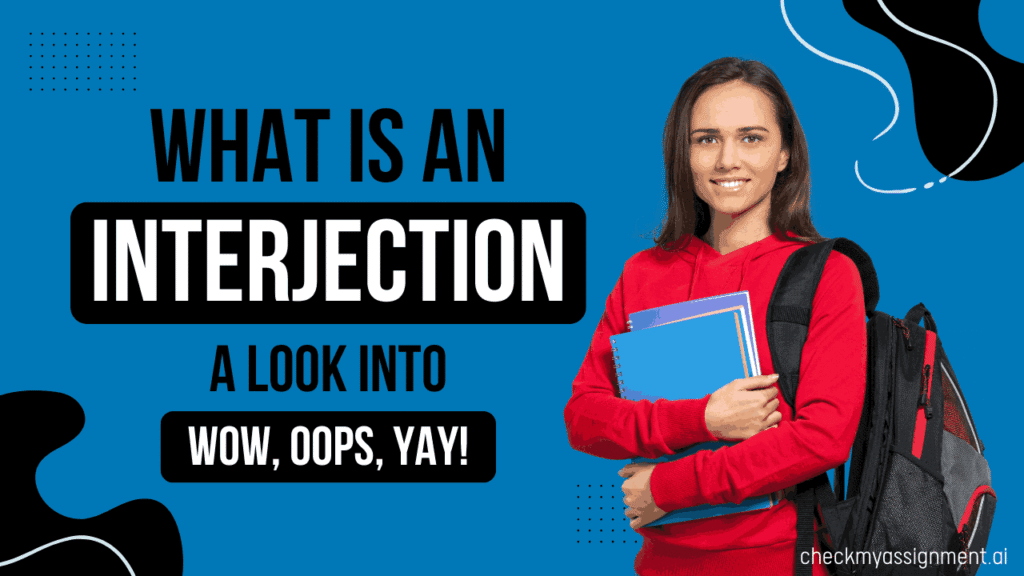What is an Interjection? The Wild World of Whoa! Oops! Yay!
Table of Contents
ToggleBegin with a question: Have you ever stubbed your toe and yelled, “Ouch!”? Or maybe you got a surprise birthday cake and shouted, “Wow!” Or you spilt coffee on your laptop and groaned, “Ugh…” If you’ve done any of these (and let’s face it, we all have), congratulations—you’ve used an interjection and you now know what is an interjection!
What is an Interjection? The Exact Meaning of Interjection
An interjection is a word or phrase used to express emotion or reaction. It does not have a grammatical connection to the sentence it appears in. It is just there. Like the person at the party yelling “Shots!” while everyone else is sipping tea quietly.
Interjections are the party crashers of the English language. They burst in and shout their feelings, usually followed by an exclamation mark. They are punchy and full of attitude. And the best part? You don’t even need to overthink grammar rules to use them!
In technical terms, an interjection is a part of speech used to express a spontaneous feeling or reaction.
They can show happiness, surprise, disgust, anger, excitement, confusion—you name it.
Let’s break down the basics so that we’ll have a little fun with examples.
Examples of Interjections in Action
Let’s look at a few in context:
“Yay! I passed my driving test!”
“Ugh, Mondays are the worst.”
“Oops! I deleted the file by mistake.”
“Hmm, I am not sure that is the right answer.”
“Whoa! That roller coaster was insane!”
“Ah, that’s the spot.” (While scratching an itch)
“Hey! Watch where you’re going!”
“Well, I didn’t expect that.”
Notice how these interjections are often at the beginning of a sentence? That’s their favourite hangout spot. But they can pop up almost anywhere for dramatic effect.
Expression of Emotion Through Types of Interjections
Did you know interjections come in different flavours? Here are a few types:
1. Emotive Interjections
These express strong feelings. Think of them as emojis in word form.
Wow! That is amazing.
Yuck! This milk is sour.
Oh no! I left the oven on.
2. Volitive Interjections
These are used to give commands or express wishes.
Shh! The movie’s starting.
Hey! Come back here!
Bravo! That was a brilliant performance!
3. Cognitive or Hesitation Interjections
They express thought or uncertainty or hesitation.
Um… I think I left my keys at work.
Er… What was your name again?
Hmm… Let me think about it.
4. Greeting and Parting Interjections
Yep, even “hello” and “goodbye” are technically interjections!
Hi! Long time no see.
Bye! Catch you later.
Yo! What’s up?
Punctuation: The Interjection’s Favorite Accessory
Interjections are drama queens. They love punctuation and especially exclamation marks.
Excited? Use an exclamation mark. “Yay!”
Unsure? Maybe a period or ellipsis. “Hmm…”
Mild? A comma can do. “Well, I guess that’s okay.”
Don’t be afraid to go big with interjections. After all, “Yay.” and “Yay!” hit very differently.
Interjections Across Pop Culture
Interjections aren’t just for grammar geeks. They’re sprinkled all over pop culture:
“D’oh!” – Homer Simpson (frustration/disappointment)
“Bazinga!” – Sheldon Cooper from The Big Bang Theory (surprise/trickery)
“Zoinks!” – Shaggy from Scooby-Doo (shock/fear)“
Whoa!” – Keanu Reeves in basically everything
They help characters express their personality in one-word sound bites. (Writers love them for this reason.)
The History of Interjections (They Have Been Around That Long)
Even ancient languages had interjections. Latin had “heu!” (woe!) and “vae!” (alas!). Shakespeare was full of them: “Fie!” (disgust), “O!” (surprise, love, sorrow—he was dramatic like that).
If someone says interjections aren’t “real” parts of speech, just remind them: interjections have been interrupting sentences since before English was even a thing.
When to Use Interjections
Use Them When:
Writing informal content like blogs, texts, or dialogue.
Expressing quick emotions or reactions.
Making your writing sound natural and conversational.
Avoid Them When:
Writing academic or formal documents.
Drafting a resume or cover letter (no “Yikes!” if you’re listing job losses).
You’re overdoing it — “Wow! Yay! Oh no! Whee! Woohoo!” in one sentence might overwhelm your reading.
Like hot sauce, interjections are great in small doses. Too many, and your writing becomes a mess of shouting.
Fun Exercise: Spot the Interjection!
Try spotting the interjections in this sentence:
“Oh no, ugh, I left my umbrella again—dang it!”
How many did you find? Answer: Four.
“Oh no”, “ugh”, and “dang it” are all interjections. (“Again” is just an adverb tagging along.)
Wrapping Up: What is an Interjection?
So, next time you blurt out “Whoa!” or sigh “Phew”. Take a moment to appreciate that tiny word. It is doing a lot of heavy lifting: carrying your emotion and giving your language that little spark of life.
Interjections may be the smallest part of speech, but they sure know how to make some noise.
Yay! You made it to the end.
Now go forth and interject with confidence.

